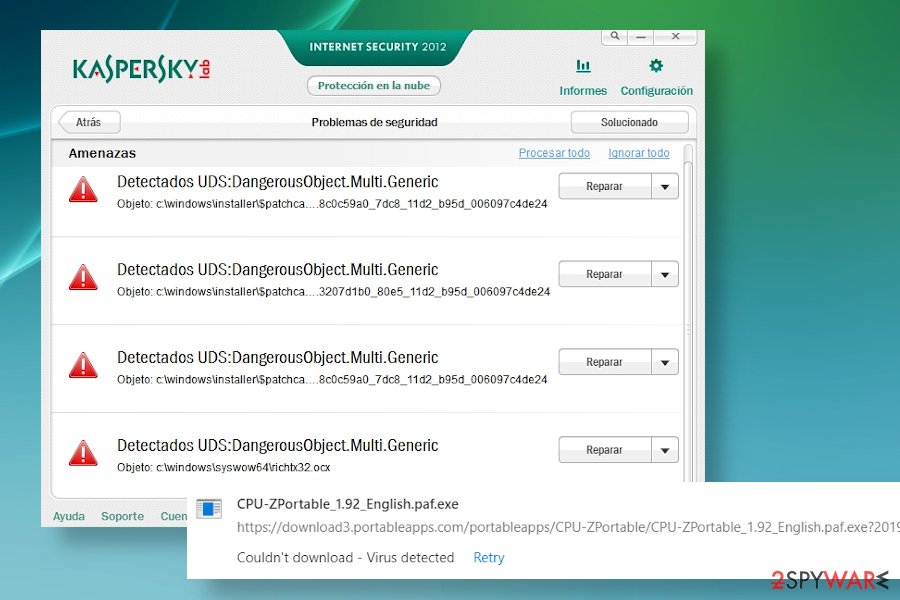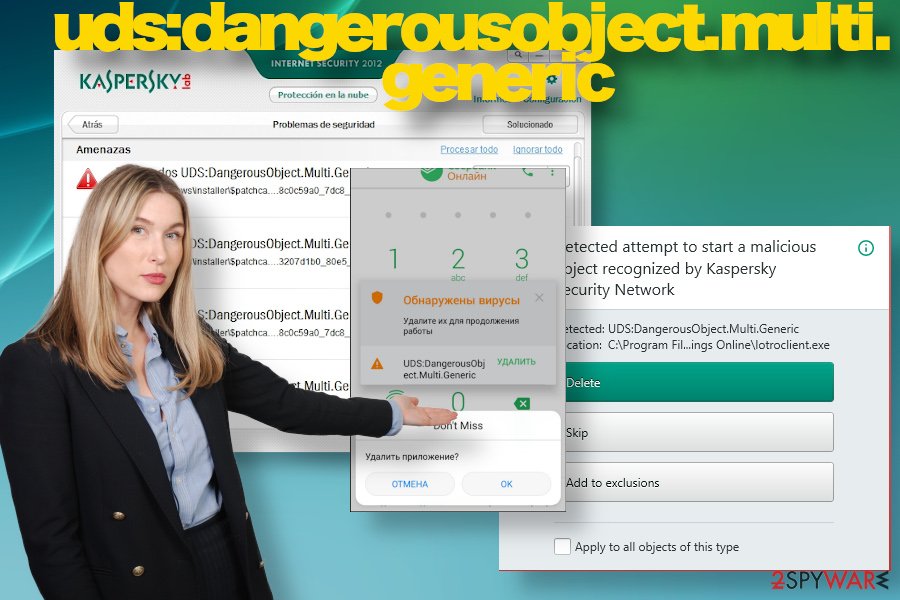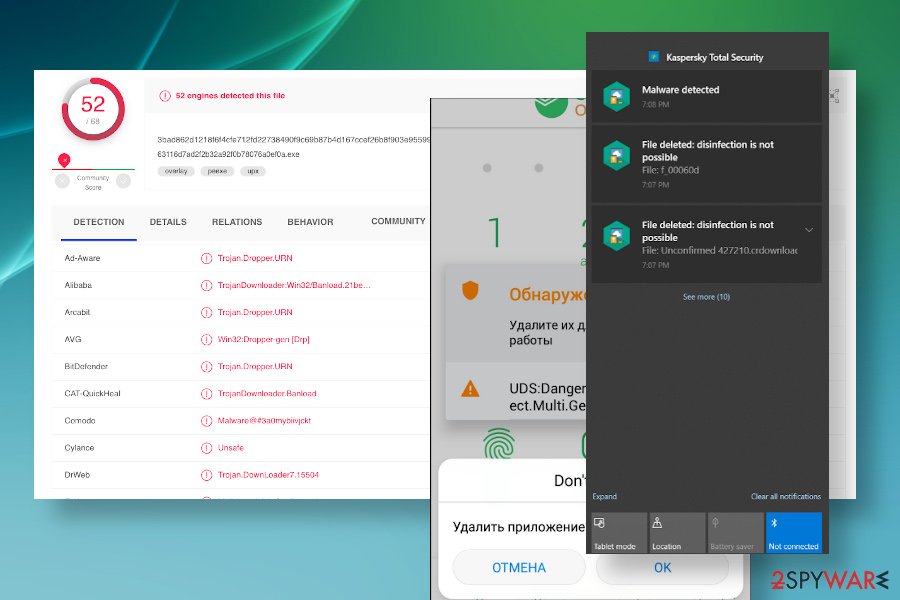Uds dangerousobject.multi.generic is the heuristic detection name for dangerous ransomware or trojan


Uds dangerousobject.multi.generic is a detection name that can either be a false positive or imply a ransomware or trojan infection on the system. The reports of this detection have emerged in 2018[1] when people using Kaspersky Security Network (KSN) invaded the Steam community forum. According to reports, the name is usually connected to software like CPU-Z updates, games from GameHouse, cracks, or keygens. The non-false positive detection usually points out to a malicious java.exe or 63116d7ad2f2b32a92f0b78076a0ef0a.exe files.
“There is an active virus UDS:Dangerous.Object.Multi.Generic” popup may be a false-positive detection (in many cases, AV may feature false virus definitions). However, reputable sources[2] reported this problem to be bound to a yet unspecified ransomware infection, which is similar to Petya or Wannacry. However, the closer analysis showed that it’s not ransomware, but rather a Trojan. Therefore, uses should not ignore the AV scanner, which reports this detection as it may lead to file encryption, loss of personal files, or system crash.
| Name | Uds dangerousobject.multi.generic |
| Classification | It’s a heuristic detection name, which may either be a false-positive or indicate a trojan or ransomware infection |
| AV engines | This detection name is specifically bound to Kaspersky Security Network (KSN). However, other reputable security software, including McAfee can return the detection as well |
| Related names | UnclassifiedMalware, Trojan.Script.Suspic.gen, Win32:Dropper-gen [Drp], Trojan.Dropper.URN, Trojan.DownLoader7.15504, etc.[3] |
| Symptoms | This detection may refer to an extremely dangerous malware infection on the system. In case of a ransomware attack, personal files can get locked, ransom note dropped, lock screen generated, etc. In the case of a trojan, the system may become sluggish, unresponsive, certain software can become idle, etc. |
| Danger level | High. Even though the alarm may be false, users should check the system and ensure that it’s virus-free. Otherwise, there’s a high risk of losing personal files and exposing personal information to hackers |
| Removal | Uds:dangerousobject.multi.generic removal cannot be performed manually. The only way is to run a scan with a professional security tool |
| Fix damage | Trojans and similar infections run malicious scripts, insert malicious entries in systems directories, block software, etc. In general, these threats cause damage to the system, which is not restored upon their removal. Thus, it is advisable to run a scan with Reimage Reimage Cleaner Intego to fix suchlike damage |
People run into the uds dangerousobject multi generic detection if they have a particular anti-virus engine installed on their devices. Usually, the detection is triggered by a malicious 63116d7ad2f2b32a92f0b78076a0ef0a.exe or java.exe file, although other files can also trigger it.
According to people who encountered this popup, the Uds dangerousobject.multi.generic virus warning keeps reappearing on the screen even after running a thorough system scan with other AV engines and removal of detected threats. In such a case, there’s a high probability that the detection is a false positive[4].
If you download a file and your antivirus jumps into action and informs you the file is harmful, it probably is. If you’ve run into a false positive and the file is actually safe, most other antivirus programs shouldn’t make the same mistake.
To remove Uds dangerousobject.multi.generic virus popups from the system, users should include the detection into the exceptions list on the AV settings. If nevertheless, the scan with an AV engine ends up with malicious virus detection, you should immediately quarantine all malicious entries.
The Uds dangerousobject.multi.generic virus detected by Kaspersky can be found under diverse names depending on the security tool that is used on the system. The most common detections are the following:
- Artemis!63116D7AD2F2
- Trojan.Gen.2
- Gen:Variant.Symmi.2215
- VBS/Dldr.Rowm.A
- Script.Trojan.Suspic.Pdcl
- Trojan.Script.Siggen.degalj
- Script.Trojan.Agent.FZPT9I
- JS:Downloader-BSP [Trj]
- VBS/Agent.NCO
- VBS.Downloader.Trojan
- Trojan.MSIL.Agent.QOJ
- MSIL/Agent.QOJ!tr
- Trojan/Win32.Agent, etc.
In case Uds dangerousobject.multi.generic detection is not a false-positive, it can be a reference to a dangerous Trojan. The malware that belongs to this class is one of the most dangerous as they can silently run in the background and record personal information about PC’s user. Moreover, it may connect to C2 servers and adduce its managers with technical information about the victim’s PC to allow hackers to access the system remotely.
Uds dangerousobject multi generic trojan virus may get inside the system in many ways, for example, malicious spam email attachments, seemingly reliable applications downloaded from shady download sites, software cracks, keygens, and similar. In any way, the tasks that suchlike virus is programmed to perform is highly malicious and can lead to data or money loss, as well as identity theft.
Although Windows is known to be mainly affected by this problem, some people are actively looking for an answer on how to remove Uds dangerousobject.multi.generic Android virus. According to them, the Android version of this virus is bound to a malicious java.exe file.

Uds dangerousobject.multi.generic Kaspersky detection can imply a malicious trojan infection

Uds dangerousobject.multi.generic Kaspersky detection can imply a malicious trojan infection
Regardless of the OS type, the uds:dangerousobject.multi.generic removal is the immediate step that people have to take if scanning of the system ends up with the warning popup. A dangerous Trojan can initiate such and similar activities:
- Run in the background and connect C2 server controlled by hackers;
- Harvest banking information, saved password, browsing history;
- Log keystrokes, use a video camera, take screenshots regularly;
- Weaken system’s security and increase vulnerability;
- Create backdoor access and lead to ransomware or other virus infections;
- Provide administrative privileges to manage the system, etc.
Since this detection is not specifically bound to single virus infection, trying to detect and decontaminate it manually would be an empty attempt. If the detection appears to be real, perform Uds dangerousobject.multi.generic removal automatically. First of all, ensure that the security tool is has the latest definitions and run the scan with it when in Safe Mode.
According to some users, they have managed to remove Uds dangerousobject.multi.generic from the system by cleaning temp files and some recently installed freeware. However, usually, decontamination of this malware required clearing Java cache and then elimination of malicious processes with tools like SpyHunter 5Combo Cleaner.
Upon successful elimination of the Uds dangerousobject.multi.generic virus, ensure the recovery of the system. A trojan might have deleted some registries and core components of the system, so running a scan with Reimage Reimage Cleaner Intego is highly advisable.
Do not rely on any content presented in a misleading way
Trojans and suchlike cyber infections are being distributed in many ways. Unfortunately, none of them are easily recognizable. Malicious files that carry trojan or ransomware payloads are disguised in a comprehensive manner. If the infected file is launched, well-programmed malware runs in the background and performs multiple performances to evade detection and prolong the prevalence.
However, people should think of how to evade Trojan attacks in the first place instead of contemplating on how to get rid of them. The biggest piece of advice is to keep a powerful security software installed on the system. Updating it and installing its virus definitions continuously is a key to a virus-free machine. However, sometimes antivirus protection is not the utmost solution. Experts from dieviren.de[5] recommend people minding the following security measures for good:
- Keep the software on your machine up-to-date;
- Stay away from suspicious email messages that contain attachments. If you consider it to be non-malicious, though trying to open it required enabling macros, it’s a sign of a possible virus attack;
- Do not download pirated software. If possible, rely on legitimate download sources all the time;
- Ignore hyperlinks that occur on random websites or social media platforms;
- Do not click on popups saying that you need to update software, etc.
In general, ignore any suspicious online content as it may be scripted by hackers. Visit reliable websites and think twice before downloading any software.

Uds dangerousobject.multi.generic detection on Android and Windows should not be ignored as it may not necessarily be false-positive

Uds dangerousobject.multi.generic detection on Android and Windows should not be ignored as it may not necessarily be false-positive
Get rid of Uds dangerousobject.multi.generic trojan to recover the system’s performance
Uds dangerousobject multi generic removal is a complicated task because this detection signifies a stealthy trojan virus on the system. Therefore, people who have been warned about infected machines should no longer postpone a thorough system scan unless they don’t mind a banking trojan to leak personal data.
If, nevertheless, the Kaspersky Uds dangerousobject.multi.generic detection is brought to you by a single security tool and it seems false-positive, you should try to change AV settings, and add certain pages or files that are flagged as malicious to the whitelist.
Otherwise, to remove dangerousobject multi generic trojans and suchlike threats from your machine, run a full system scan with an alternative security tool, for example, SpyHunter 5Combo Cleaner or Malwarebytes when the system is booted in the Safe Mode with Networking. Otherwise, malicious java.exe or similar executables may infringe the scanner and prevent AV from launching.
This entry was posted on 2020-06-01 at 03:59 and is filed under Trojans, Viruses.

